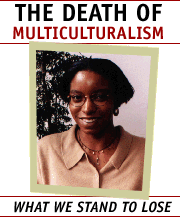|
POLITICS & COMMUNITY

by leslie hinkson
published august 1, 1996
|
Academia has often been criticized as being an extremely insular, removed community having little to do with the real world. Liberal arts programs in particular have been the target of vicious attacks by critics who believe the curriculum has become overrun by "soft" courses. "Soft"
refers to classes and departments that are seen to stray from
classically accepted modes of thought in an environment where, not too long
ago, the only ones existing within its walls were almost
exclusively white males. These courses are seen as having no real value -
intellectually or practically - except to further leftist propaganda among
our young elite.
As the Left is criticized for leading academia astray in its call for a multicultural curriculum, the Right has scored its own victory. As of July 1995, the University of California Board of Regents (at the urging of Governor Pete Wilson) effectively abandoned Affirmative Action policies in both its hiring and admissions processes. The result has been to turn academia into another "real world" playing field of factional politics, where race and race relations
are reduced to issues for political hopefuls to kick around in order to
score big with voters.
But when the votes are counted and the election is over, what happens to the
American university system? If the University of California is but the
first of many university systems to take a hard stance against affirmative
action policies, what will this mean in terms of the future face of America's
college educated population? And how will this effect the way in which
they are educated?
|
|
Liberal arts programs have been viciously attacked.
|
In a study prepared for the University of California Board of Regents in
1995, statistics showed that without Affirmative Action policies, the number of
African-American students on campus would drop by 50%, amounting to less than
3% of the student body. African Americans represent approximately 7% of the
population of California. The number of Latino students would fall as well,
while the number of Asian-American students would rise from its current level of 33% to between 48 and 58%. A number for women was not made available. Even when
keeping in mind that this study merely reflects the demographics of one university system, one is presented with a gloomy picture of the future of diversity on the
American college campus nonetheless.
It should be clear why this issue should be of concern to American society
as a whole. In the late 20th century, the job market has become
increasingly competitive. A college degree in many cases is not enough to
ensure a strong foothold in the ever accelerating rat race. If access to a college education for women and people of color becomes more difficult (and decisions like those made by the University of California Board of Regents makes that a near-certainty), then access to many sectors of the American job market
will be closed off to them as well. Considering also that at present, 34% of all African-Americans and 32% of all Latinos live below the poverty level, we could
expect those numbers to increase.
|
|
The number of Black, Hispanic and female students and faculty will decline
dramatically.
|
But what does this have to do with academia? In a perfect world, higher
education would be synonymous with the quest for knowledge and, more
specifically, truth. The surest and quickest way to the truth is through
encouraging the expression of divergent points of view, the
promotion of active discussion and debate, and the commitment to
developing different paradigms through which students are able to view the
world, history, and art. Though there are many who would refute this, a multicultural curriculum is the surest path to finding the truth in academic America.
Multiculturalism, in its purest form, is not the propagation of anti-white
male sentiment. Nor is it the rejection of canonical teachings and modes
of thought within the academy. Rather, it is the acknowledgment that
knowledge is not limited to Plato; that literature did not die with
Shakespeare; and that American culture and history has been shaped by many
different peoples and ideologies. It gives us hope that there are great
thinkers yet to come and artists yet to create masterpieces beyond our
wildest imaginings. By learning that an "America" existed before
Columbus; viewing the American political structure from a feminist
perspective; and reading Melville alongside Baldwin, one realizes that the
one absolute of knowledge is it has no boundaries.
|
|
Muliticulturalism gives us hope that there are great thinkers yet to come.
|
A multicultural curriculum can only succeed in an environment in which the
participation level of diverse groups of men and women is encouraged. By
abandoning Affirmative Action policies, the University of California Board of
Regents sent a message to college campuses across the state that divergent
opinion is not needed in the California university system. While
Affirmative Action in its present form is, in some cases, an outmoded and
over-simplified attempt to redress the problems of sexism and racism in America,
to simply toss it out without attempting modification reveals an impatience and
loss of hope. It tells far more of the decline of American society for the past
quarter-century than most pundit statements.
If what statistics say holds true, and if the trend towards
repealing Affirmative Action continues, the number of Black, Hispanic and female
students and faculty will decline dramatically in the next decade. Without
their membership within academia, there is no hope that multiculturalism,
whose livelihood depends upon the active participation of all society's members,
will survive in America. With its demise will come the end of what could have been
an era of intellectual growth and promise.
Leslie Hinkson, 24, lives and writes in New York City. She currently works
for the Granite Broadcasting Corporation.
© 1996 Tripod, Inc. All Rights Reserved.

|
